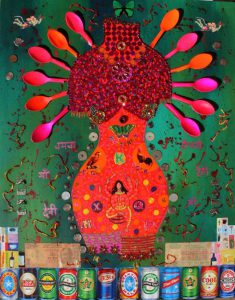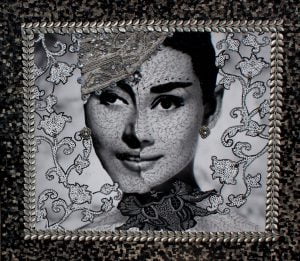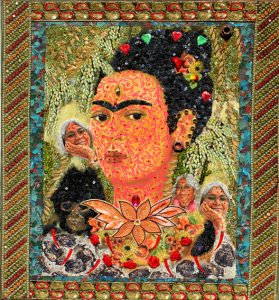It is present on the big screen. It is present on the posters on the bus when we go to work. It is present in the songs we hum and the books we read. The male gaze is everywhere. It objectifies the subject. It makes the represented, feel displayed. It essentially makes the spectator the man and the spectacle the woman.
Kanchan Chander sheds this male gaze and creates a space where the spectator and the spectacle becomes the woman. A common theme in her paintings, Devi, is often shown surrounded with mundane objects like plastic spoons, nails, coins, and antithetical objects like beer cans, which creates a juxtaposition of female liberation and oppression. Kanchan Chander creates art that forces the viewers to shed their institutionalised male gaze.

Devi Nouveau. Image Source: Kanchans Artwork
The Devi and the torso become common themes throughout her artwork. When asked about why she chose the female body, specifically the torso as her inspiration, Kanchan Chander responds that the torso is “the centre of femininity and sensuality.” The torso is shown as the sensual epicentre of the woman without playing into voyeuristic fantasies of the audience. Playing with this embodiment, Kanchan Chander creates work that rewrites beauty norms, sensuality, and even motherhood in ways devoid of the male gaze. She says:
“If a man makes a female body he makes it with a male gaze, you will not find anything sexualised in my torsos because its independent of the male gaze. To view the art it has to remove male gaze “

Yogini
In the world of art, a narrative becomes significant. It becomes the selling point in this rapidly commercialising and developing country. The male gaze controls and dictates who gets to tell the story, who gets represented and who becomes the passive character in a story about them. The male gaze creates an intricate system of power which Kanchan breaks, by choosing to radically depict sexualised female body parts in a rather mundane and desexualised manner.
“I can’t even imagine painting a man’s torso. The one time I did, I decorated it with nuts and bolts. If you noticed, the nuts and bolts are in all the right places! When I create any part of the female body, the torso, or even open legs, they won’t look sexual. But if a man would have made these same paintings every part would have been sexualised.”
With the hidden desire of wanting to become an actress, Kanchan further elaborates on the concept of the male gaze through her Hollywood-Bollywood series.

Hollywood-Bollywood. Image Source: Kanchans Artwork
“I only depicted tragedy queens. I bedazzled them with sequins and mundane materials that I found at hardware stores. I put every sequin individually by myself, and the process has not become cathartic.”
The ‘tragedy queens’ bedazzled with sequins and hardware, allow the audience to question female representation in cinema. It brings to the forefront the extent to which the male gaze and sexual objectification of the female body is rooted in our culture.
Kanchan Chander further creates pieces of art that delve into the psychological effect of this deep rooted misogyny that silences the screams of women. She plays with objectification theory. In her work Mental Block: Summer 2013, where her screams are silenced and her helplessness in a patriarchal society are captured. The raw, vulnerability of the female psyche is ripped open for everyone to see. Kanchan Chander doesn’t shy away from using vulnerability as a tool to start conversation amongst the spectators of her art.
“The video was hard to put out. I was in a mental block that summer, unable to create work. My block, my silent screams, my struggle as a woman, became my work. Such work can only be created by a woman because it’s a woman’s psyche. I had numerous women come up to me after I showed this piece of work who understood the work on a personal level.”
On talking about being called a ‘Feminist Artist’, Kanchan Chander resisted the categorisation.
“I am an artist. Not a ‘female’ artist. Not a ‘feminist’ artist. I am a woman, so I am sensitive to the issues of women. But why do I need to identify as a feminist artist in order to do so? People are eager to categorise each other.Why does my work and creativity need to be limited? An artist always needs to evolve, in medium and in content. But you can categorise me as whoever. I don’t care as long as I can create what I want and it sells.”
Kanchan Chander paints her own reality, calling her art ‘autobiographical’. Her pieces tell the story of an empowered, dynamic artist.
In her painting Frida and Me, the mythology and rationality in Kanchan Chadler’s work are further highlighted when put in contrast with Kahlo who acts as an embodiment of this very same mythology and rationality.
“I was enamoured by Frida and related to her pain. I was inspired by how she painted her reality because to some extent I could relate to it.”

Frida and Me. Image Source: Kanchans Artwork
Despite resistance, it is hard to not see Kanchan Chander as a feminist artist. As a mentor and a teacher, she uses art as a platform that not only makes space for emotions and vulnerability to be seen as credible art and form of change but also a space for changing the visual semantics of art by filling it with the female body. Kanchan Chander paints her own reality, calling her art ‘autobiographical’. Her pieces tell the story of an empowered, dynamic artist.
Also read: The Feminist Film: Defying The Male Gaze Of Celluloid
Featured Image Source: Art Cultural Festival
About the author(s)
Undergraduate studying Religion and Gender, activist, feminist. Gender pronouns - she/her/hers





I really enjoyed reading this !!
Please dear your contact number send